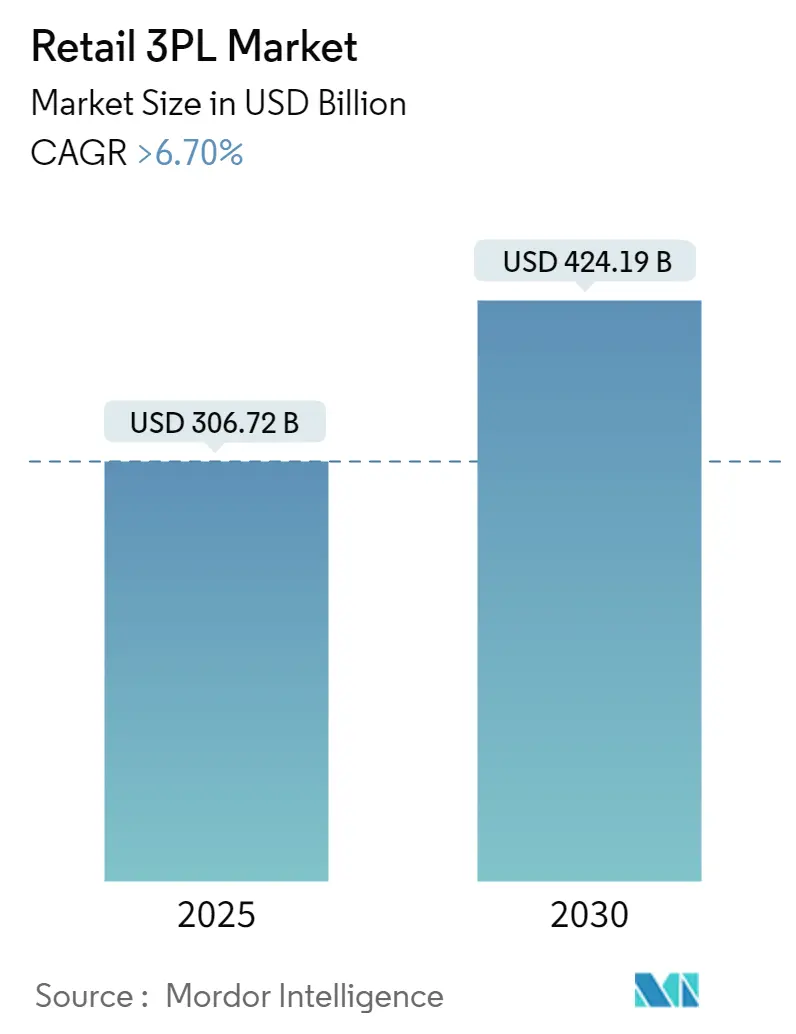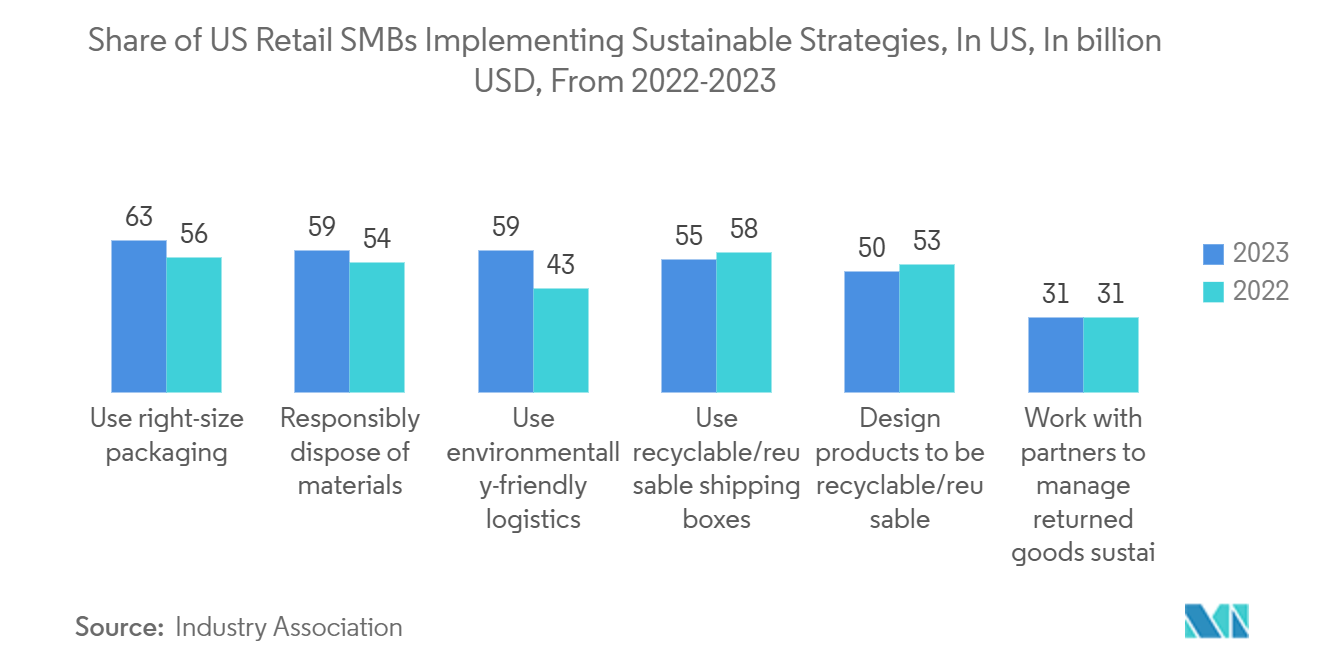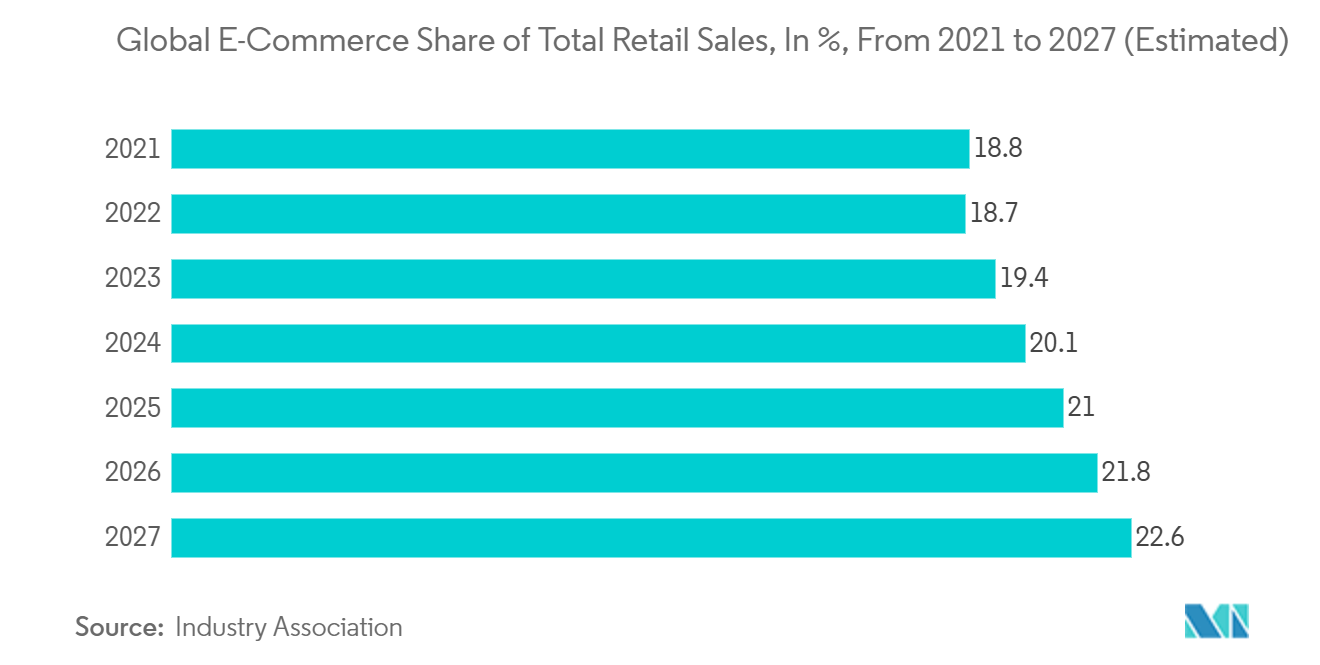Retail 3PL Market Analysis
The Retail 3PL Market size is estimated at USD 306.72 billion in 2025, and is expected to reach USD 424.19 billion by 2030, at a CAGR of greater than 6.7% during the forecast period (2025-2030).
The global retail 3PL market is witnessing significant growth, primarily fueled by the swift rise of e-commerce and the escalating need for efficient supply chain solutions. Retail 3PL providers are increasingly leveraging technologies such as AI and IoT to boost efficiency and cater to the surging consumer demand for same-day or next-day delivery services. Major drivers of this market include a global surge of over 20% in online retail sales from 2023 to 2024, and the growing trend of omnichannel retailing, which demands integrated logistics solutions.
3PL providers play a crucial role in sectors like fashion, electronics, and consumer goods, where timely and dependable delivery is paramount. As omnichannel retailing gains traction, companies are leaning on 3PLs for inventory optimization and last-mile delivery management.
Even in the face of challenges like soaring fuel prices and labor shortages, the retail 3PL market shows resilience and growth. As retailers seek more tailored and adaptable logistics solutions, 3PLs are broadening their offerings. This expansion encompasses services such as returns management and green logistics, ensuring providers stay competitive in the dynamic retail arena.
Retail 3PL Market Trends
Integration of Technology and Automation
3PL organizations are increasingly collaborating with AI-driven software providers to meet the demands of a challenging operating environment. This trend is driven by the need to enhance operational efficiency through advanced technology. An efficient warehouse prioritizes safety, and by minimizing accidents, a 3PL provider can more effectively protect both its personnel and the products stored. Operations free from accidents not only bolster the bottom line but also enhance customer service by minimizing injuries and disruptions in product movement.
Presently, XPO Logistics has been utilizing AI-driven warehouse management platforms to streamline operations for global 3PLs like DHL and DB, from picking and put-away to ensuring inventory accuracy. Many warehouses struggle to position products optimally due to a lack of awareness about several data points. These include real-time incoming orders, the number of workers on a shift, and the expertise of those workers.
This growing adoption of AI technology in 3PL operations highlights a significant shift towards more efficient and safer warehouse management. By leveraging AI, 3PL providers can achieve better operational outcomes, ultimately leading to improved customer satisfaction and profitability.
Growth in E-commerce and Demand for Efficient 3PL Solution
According to industry sources, e-commerce is rapidly expanding, with online sales projected to account for 21% of global retail by 2024, up from 18% in 2021. This surge is prompting retailers to increasingly depend on third-party logistics (3PL) providers for efficient logistics management. The growing reliance on 3PLs is driven by the need to handle the complexities of supply chain operations, which include warehousing, inventory management, and transportation. In response to consumer demand for quicker deliveries, 3PLs are adopting technologies like AI and automation, capable of slashing order fulfillment times by 30-50%. These technologies enable real-time tracking, predictive analytics, and optimized routing, which collectively enhance the efficiency and reliability of logistics services.
As e-commerce flourishes, there's heightened emphasis on last-mile delivery, with 70% of retailers in 2023 deeming it crucial for customer satisfaction. Last-mile delivery represents the final step in the delivery process, where goods are transported from a distribution center to the end consumer. This stage is often the most time-consuming and costly part of the logistics chain. With consumers demanding swifter and more adaptable delivery choices, 3PLs are channeling investments into innovative solutions to meet the rising appetite for speedy and economical logistics. These solutions include the use of electric vehicles, drones, and crowd-sourced delivery platforms, which help reduce delivery times and costs while minimizing environmental impact. Additionally, 3PLs are enhancing their delivery networks and expanding their geographic reach to ensure timely deliveries even in remote areas.
Retail 3PL Industry Overview
The global retail 3PL market is fragmented in nature with a mix of global and local players. Some of the strong players include DSV Panalpina, DHL, Ceva Logistics, Ryder Supply Chain Solutions, C.H. Robinson, and Hub Group. Despite the restrictions and lockdowns in place around the world, governments in 2020 allowed trucks to commute at night to meet the country's internal demands, causing severe disruption in the third-party logistics industry. As the market grew due to the development of e-commerce, new third-party logistics companies began to enter the market.
Retail 3PL Market Leaders
-
DSV Panalpina
-
Kuehne + Nagel
-
C.H. Robinson
-
DHL Supply Chain & Global Forwarding
-
UPS Supply Chain Solutions
-
CEVA Logistics
- *Disclaimer: Major Players sorted in no particular order
Retail 3PL Market News
- October 2024: HIVED, an electric delivery company, has secured a partnership and investment from the Japanese firm Yamato. The collaboration aims to harness the strengths of both companies, pushing forward sustainable and tech-driven logistics in the UK and Japan. In this venture, Yamato is set to invest GBP 2 million (USD 2.5 million) in HIVED.
- October 2024: CEVA Logistics announced advanced digital solutions aimed at enhancing inventory management and last-mile delivery, specifically catering to e-commerce and retail clients. This expansion is centered on refining omnichannel logistics to meet the surging global demand, especially as online retail sales witness a year-on-year growth exceeding 20%. With the integration of state-of-the-art digital tools, CEVA is poised to transform the way retailers optimize their supply chains in an ever-evolving market.
Retail 3PL Industry Segmentation
Third-party logistics, often known as 3PL, is a system in which a company offers inventory management and delivery services to another company. A 3PL company is frequently used by a company (client) that does not have its own logistics department. In turn, the 3PL takes care of some or all of the client's logistics needs. The global retail 3PL market is segmented By Product (Foods and Beverages, Personal and Household Care, Apparel, Footwear, and Accessories, Furniture, Toys and Hobby, Electronic and Household Appliances, and Other Products), Distribution Channel (Supermarkets/Hypermarkets, Convenience Stores, and Department Stores, Specialty Stores, Online, and Other Distribution Channels), and Geography (Asia-Pacific, North America, Europe, Middle-East and Africa, and Latin America). The report offers market size and forecasts for the Global Retail 3PL Market in Value (USD Billion) for all the above segments. It also covers a comprehensive background analysis of the Global Retail 3PL Market, covering the current market trends, restraints, technological updates, and detailed information on various segments and the industry's competitive landscape. The report offers the market sizes and forecast for the Global 3PL Market in value (USD) for all the above segments.
| By Product | Foods and Beverages | ||
| Personal and Household Care | |||
| Apparel, Footwear, and Accessories | |||
| Furniture, Toys, and Hobby | |||
| Electronic and Household Appliances | |||
| Other Products | |||
| By Distribution Channel | Supermarkets/Hypermarkets, Convenience Stores, and Department Stores | ||
| Specialty Stores | |||
| Online | |||
| Other Distribution Channels | |||
| By Geography | Asia-Pacific | China | |
| Japan | |||
| India | |||
| South Korea | |||
| Rest of Asia-Pacific | |||
| North America | United States | ||
| Canada | |||
| Mexico | |||
| Europe | United Kingdom | ||
| Germany | |||
| France | |||
| Russia | |||
| Rest of Europe | |||
| Middle-East and Africa | Saudi Arabia | ||
| United Arab Emirates | |||
| Qatar | |||
| South Africa | |||
| Rest of Middle-East and Africa | |||
| Latin America | Chile | ||
| Brazil | |||
| Mexico | |||
| Argentina | |||
| Colombia | |||
| Rest of Latin America | |||
Retail 3PL Market Research Faqs
How big is the Retail 3PL Market?
The Retail 3PL Market size is expected to reach USD 306.72 billion in 2025 and grow at a CAGR of greater than 6.70% to reach USD 424.19 billion by 2030.
What is the current Retail 3PL Market size?
In 2025, the Retail 3PL Market size is expected to reach USD 306.72 billion.
Who are the key players in Retail 3PL Market?
DSV Panalpina, Kuehne + Nagel, C.H. Robinson, DHL Supply Chain & Global Forwarding, UPS Supply Chain Solutions and CEVA Logistics are the major companies operating in the Retail 3PL Market.
Which is the fastest growing region in Retail 3PL Market?
Asia Pacific is estimated to grow at the highest CAGR over the forecast period (2025-2030).
Which region has the biggest share in Retail 3PL Market?
In 2025, the North America and Europe accounts for the largest market share in Retail 3PL Market.
What years does this Retail 3PL Market cover, and what was the market size in 2024?
In 2024, the Retail 3PL Market size was estimated at USD 286.17 billion. The report covers the Retail 3PL Market historical market size for years: 2024. The report also forecasts the Retail 3PL Market size for years: 2025, 2026, 2027, 2028, 2029 and 2030.
Our Best Selling Reports
Retail 3PL Industry Report
Statistics for the 2025 Retail 3PL market share, size and revenue growth rate, created by Mordor Intelligence™ Industry Reports. Retail 3PL analysis includes a market forecast outlook for 2025 to 2030 and historical overview. Get a sample of this industry analysis as a free report PDF download.







